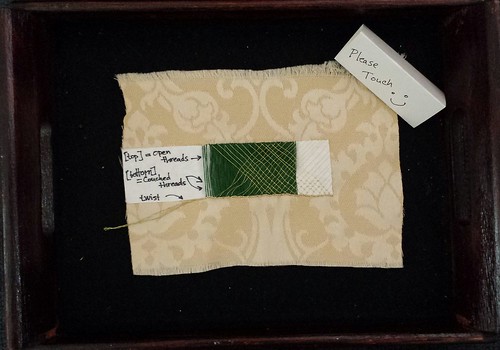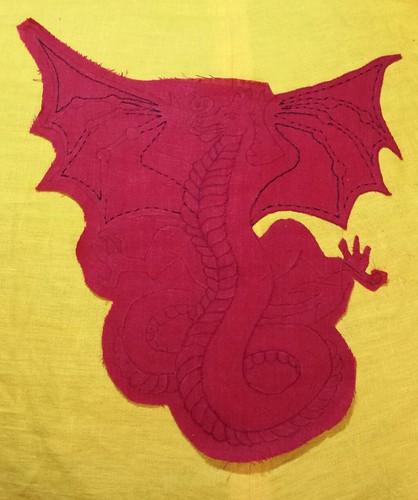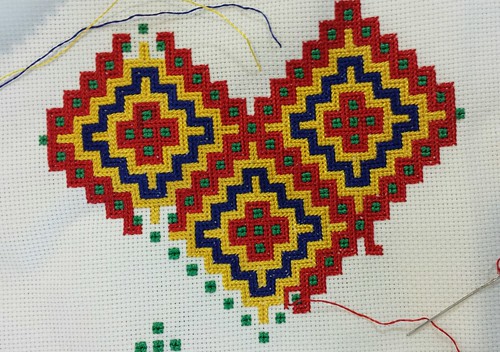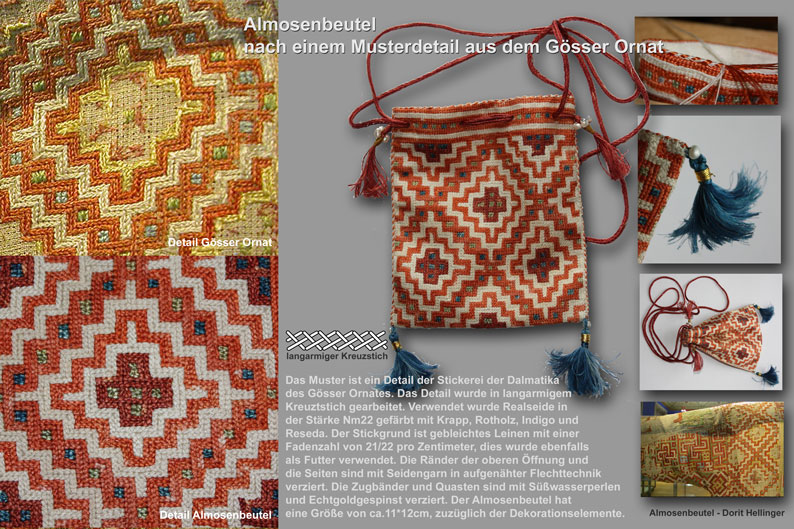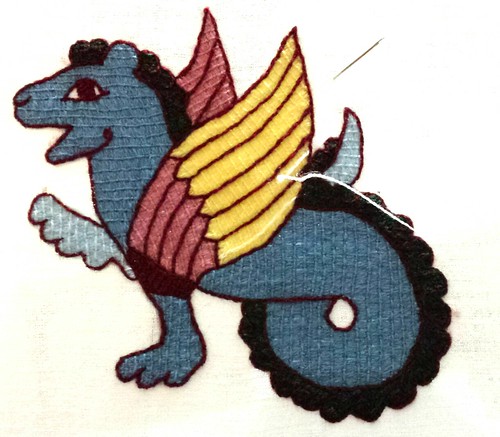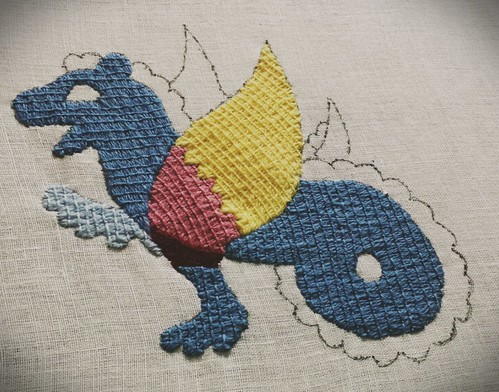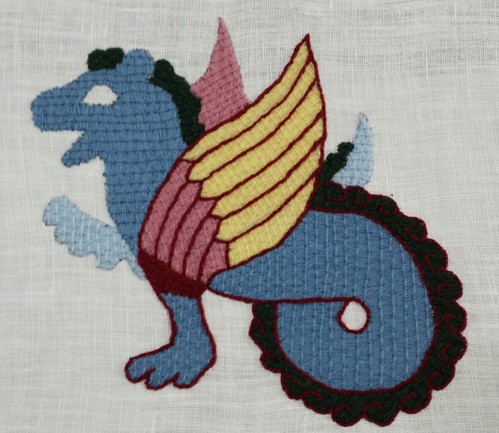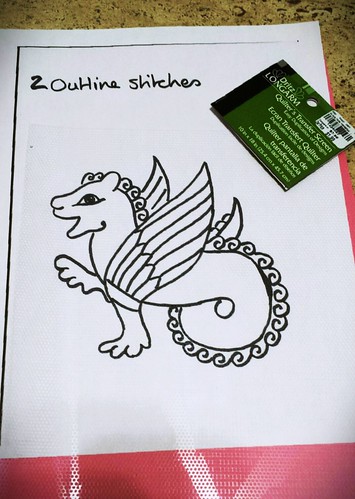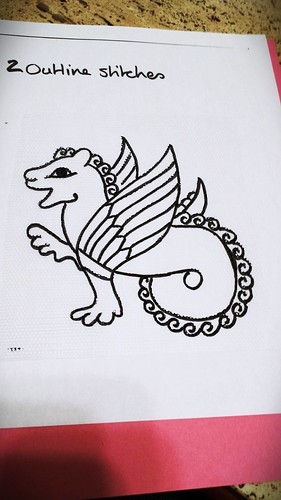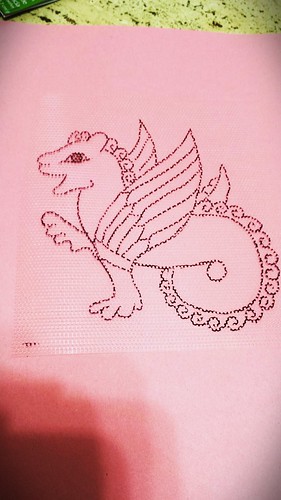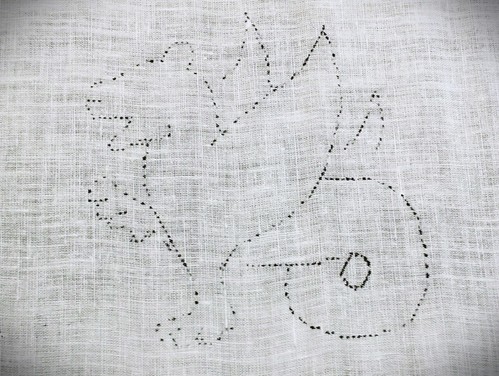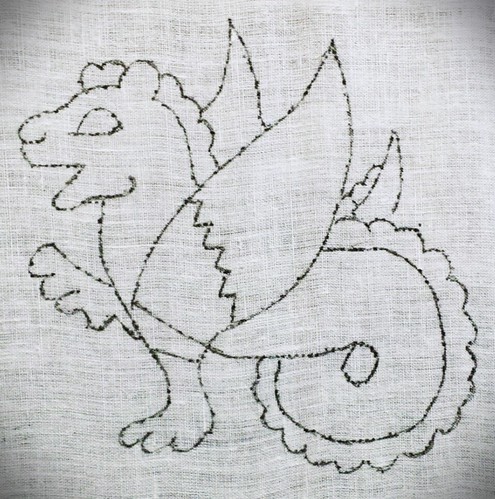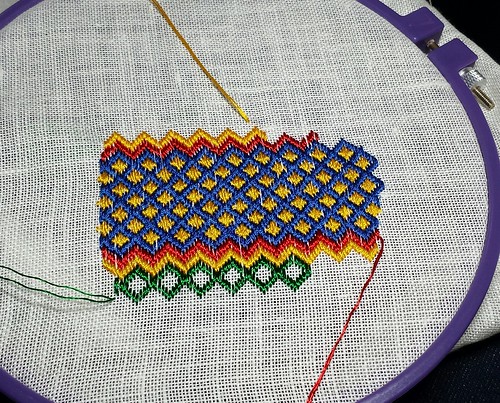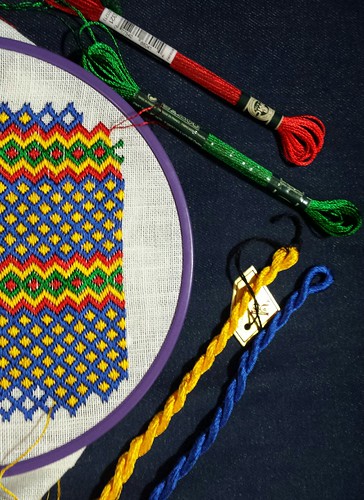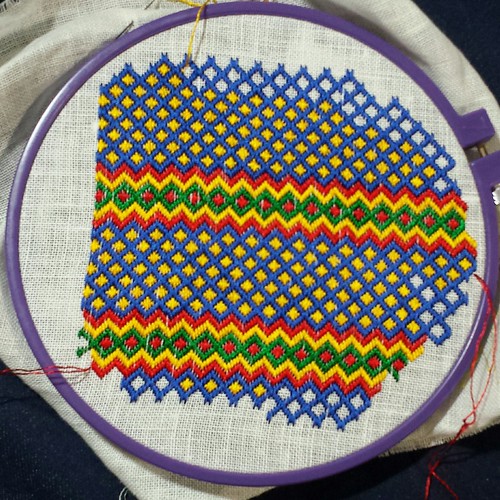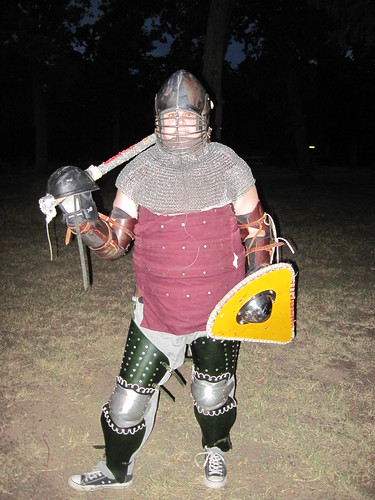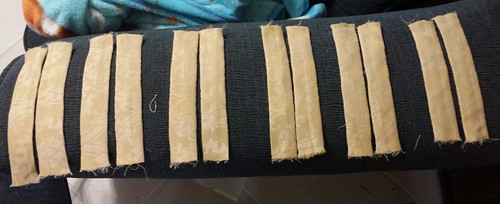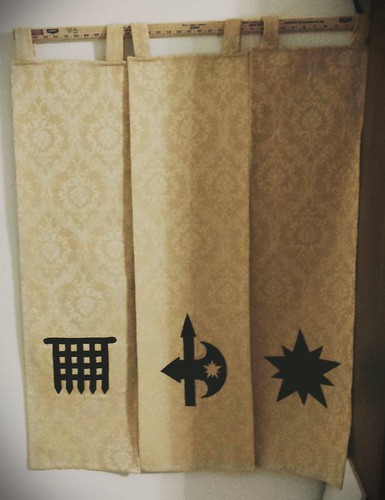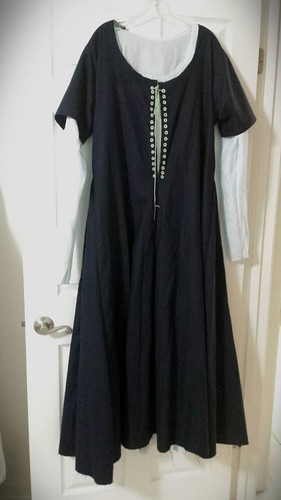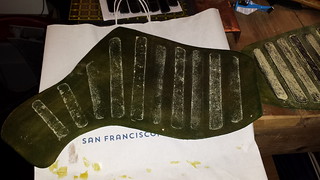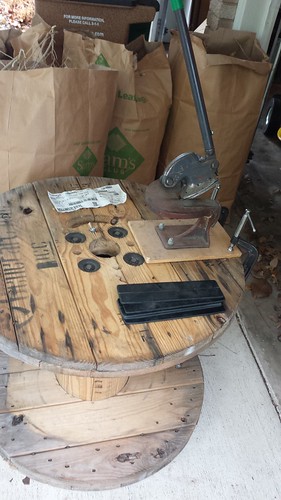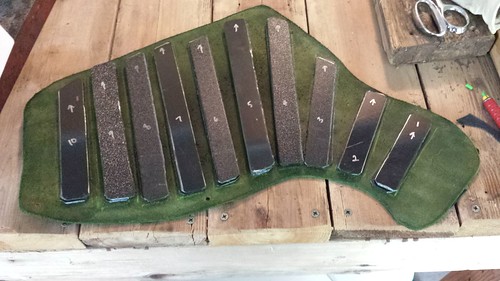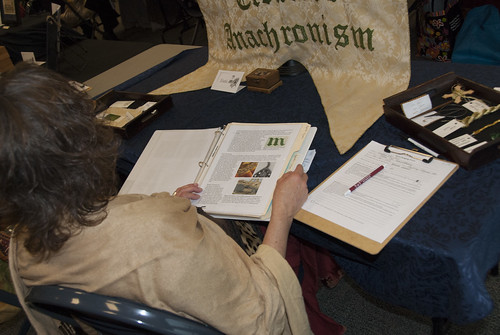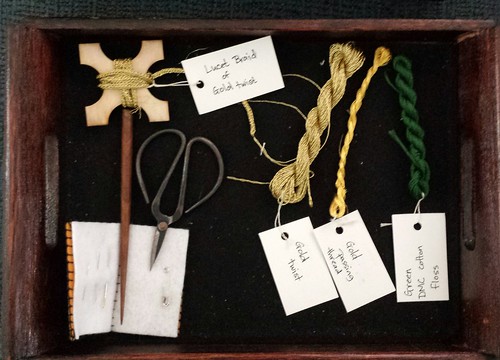I have a little time off for the holidays and my fun project is a heraldic surcoat for a friend of mine. Here are a few teaser photos of the work in progress. The surcoat itself is machine sewn. The cross was appliqued with my sewing machine using a blanket stitch after I ironed down all the edges. The embroidery is by hand using a #12 pearl cotton. The wyvern is going to be all by hand, both applique and embroidery. The term "fiddly" doesn't even begin to describe the displayed wyvern.
Tuesday, December 30, 2014
Friday, December 19, 2014
Long arm cross stitch
Thursday, October 23, 2014
Long Arm Cross Stitch
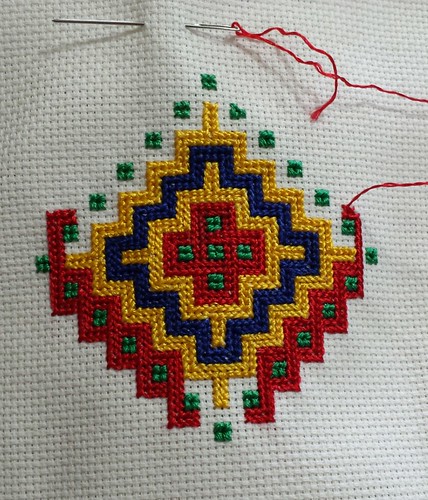
One thing that really makes long arm cross stitch look nice is the shine off silk provides a directionality and flow for the stitching. My spun silk is soft and nice, but not as great on shine. I rummaged until I found a box of cheap sari silks that I bought a few years back on an impulse buy. They aren't the nicest silk, but they have a great shine! I debated ground fabric for a while. I pulled out several great options - evenweave linen, some monaco cotton, and some aida. Ultimately, I surprised myself went with the aida. I have lots of it floating around. The aida is designed for cross stitch and it makes stitching easier in challenging circumstances. A lap project should be friendly and I figured there would be less squinting and fidgeting with those perfect little squares. The aida makes for a heavier ground than the linen does, but the stiffness also means I don't need a hoop - which is another plus for portability.
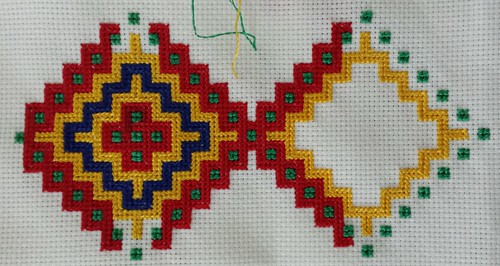
Now that I've made some progress, I can confidently say that this is a great lap project! The aida makes life easier and the silk has amazing shine. I really, really love the texture of the stitching; it makes an interesting geometric pattern really beautiful. The silks are as fussy as I remembered and they have these little slub chunks that are truly infuriating, but they were cheap enough to use on random projects. The first square was very easy to stitch, with almost no counting. I just followed the stitch lines and the geometry remained true. When it came time to start the second square I realized I needed a method, but the counting turned out to be very easy for this design. I haven't really figured out the final parameters of the project, so the connecting knot work on the edges is left open until I make some decision. I think if it's a pouch then it should be at least two squares in width. The ground is an 18 count aida to give some scale.
Sunday, October 19, 2014
Finishing touches
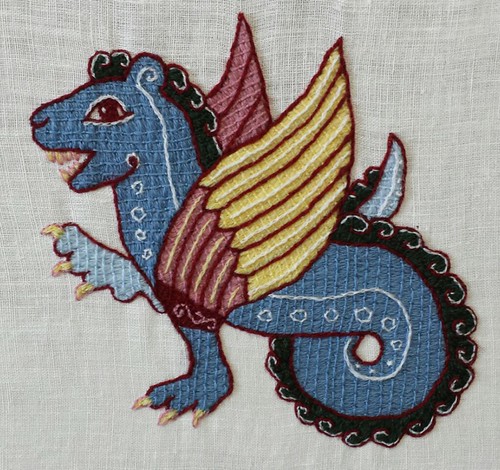
I let my little dragon sit on the frame for a short bit and finally added a few finishing touches. They pale yellow I used for the claws and teeth was so light that they didn't show up, so I added a pink outline for contrast. The maroon I used for outline, didn't give the kind of contrast I wanted on his back, so I added some white as highlight. About halfway through the swirls I wished that I'd used the pink, but it was too late. I absolutely hate picking out stitches - especially wool! So, here he is, my ferocious little dragon is all finished up.
Wednesday, October 15, 2014
Stitch along dragon
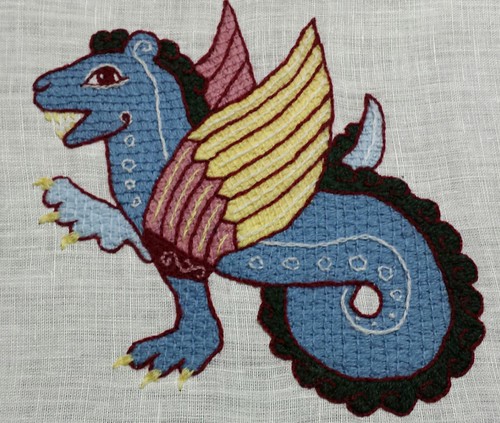 Technically, he is done here, but I will probably keep futzing about. I think that the maroon outline looses some of the detail and will need highlights. Also, I may add some detail highlights to the claws, because the yellow is so light that you can hardly see them.
Technically, he is done here, but I will probably keep futzing about. I think that the maroon outline looses some of the detail and will need highlights. Also, I may add some detail highlights to the claws, because the yellow is so light that you can hardly see them.
Monday, September 22, 2014
Progress on stitch along dragon
I'm really enjoying this stitch along. Bayeux stitch is one of those things that I've been meaning to do for quite some time. I think the hardest part of this project is staying patient with stitching progress. Fortunately, we had an SCA demo this weekend and I got a nice chunk of time to get some stitching in.
The outlining stitches always make such a difference! They are enormously satisfying, since you can begin to see the project really take shape. Stitch on!Saturday, September 20, 2014
Stitch along dragon
I started my project off by trying a new design transfer method - quilter's mesh. I picked some up recently at a clearance store for very cheap and it seems like a neat option. Here is the mesh and the dragon template I downloaded.
I traced the template using a Sharpie permanent marker and it traced pretty easily.
Here is what the mesh looks like with our cute little dragon drawn on.
I have a nice Micron pen that I use for embroidery, but the tip is small and too stiff to work well with the mesh. The mesh holes have just enough depth to snag the pen tip a little, over and over. Instead I went with the Sharpie felt tip and it worked really well. When you lift the mesh up, you get a nice little dotted line to trace.
Here is the design with all the dots connected and the lines smoothed out a bit. My little dragon is ready for stitching!
Wednesday, September 17, 2014
Laurel's Prize Tournament

Mistress Amata was kind enough to take a picture of my display this year. I brought Giant Sparkly Banner, the populace banners, one of the mouse hats, the German brickwork bag I am working on, and a few sundry fiber arts bits. I also brought my research binders and got some excellent feedback on them. I finished up my new dark blue dress and light blue under dress for the event, which I am wearing in the picture.
I took quite a few photos this year, but my camera is dying so many of them didn't turn out well. I did manage to get some good pictures and they are posted on Flickr in this album: https://www.flickr.com/photos/helene83/sets/72157647188468460/
Tuesday, September 9, 2014
Brick stitch pouch
Sometimes I post pictures to my Flickr feed with all intents to write about them - and then forget. Such is the fate of the brick stitch pouch that I am currently working on, so we will take a quick trip back in time. This project started out as a quick doodle to test out some new fibers that I picked up at the local embroidery store. Having recently played around with some filament silk, I was looking for something that was a cheaper approximation of that pretty high shine and that soft hand. DMC has recently changed their rayon line again, so I pick up some DMC red and green. The Reaissance Designs "Silky" threads were another synthetic option that was just so shiny and soft that I had to get a couple of skeins in blue and yellow.
I started stitching this little doodle using an impromptu brick stitch pattern and was really having fun with it. It just kept getting bigger!
The DMC rayon is in a very familiar skein, that are individually wrapped in a plastic tube. The rayon is very slippery and easily separates into six strands. Each strand barely has any twist at all and reminds me in feel and look of flat silks. I used two strands for the stitching on the 28 count linen, but I think that next time I would use three. The fibers are finicky like silk, so got find your hand lotion and check your cuticles. I love the feel of stitching with this rayon and really, really love it bright shine. I do not like the feeling of starting, finishing, or tying off knots with this thread because it fights back and seems to leave you with the feeling that the second you turn your back it's going to spring out of place. After finishing the stitching however, the piece feels very solid and I don't have anything wiggling out the back. The threads do snag, so you have to be careful with your hands and environment. They can also tire easily, so shorter lengths are better or you get fuzzy parts. Overall, the red and green are beautiful and shiny and soft, and I think they are a good option for that silky look.
The Renaissance Designs "Silky" comes in a lovely twisted skein and also separates out into smaller threads. These threads seem more solid than the DMC threads and were much less likely to fuzz or snag. They had the same springiness that made starting, finishing, and tying threads a bit unnerving. Two strands of the blue and yellow provided really good coverage on the linen, but they seem to have more texture and less shine. Some of the texture comes from the threads having a bit of a twist, so if you are looking for that twist this thread is a good option.
At this point, it was clearly a "Project that Must be Finished" and so I had to figure out what it was going to be. (to be continued)
Tuesday, September 2, 2014
Generally busy
Here I am modeling the latest in my armor. My leg armor is coming along and is in a wearable state, although it still needs more work to be truly finished. I also have a new helm from Master Max and a new aventail that Sir Ysfael hung for me. After a long hiatus, I am finally back in the fight.
Here are six pairs of little hanger loops ready for the assembly line as I attempt to finish up the populace banners.
Three banners finished stitching with hanger loops attached! I'm currently finishing up the last one and then I will have two full sets of three. Next I need to come up with a hanging pole arrangement that is slightly nicer than the yardstick I had hanging around the sewing area.
I knocked out a quick linen fighting surcoat for a friend. It's another project in my continued theme of reducing the fabric stash.
And last, but not least, I have a preview of my next outfit. The dress and under dress are assembled but still need finishing on the neckline and hem. It's kind of hard to see in the picture, but the dress is dark blue, the under dress is light blue, and the eyelets+lacing are in light green.
Friday, August 15, 2014
Hemming Populace Banners
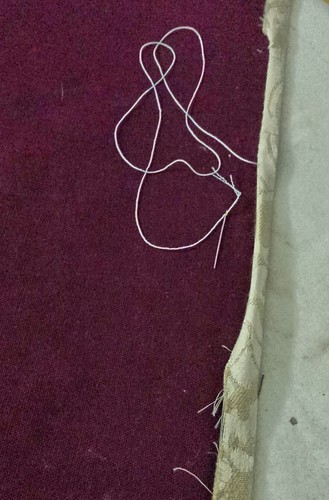
I've been busy, but there's not lots of pretty pictures for hemming six banners. I snip, clean off threads, roll the brocade, stitch, and repeat. I am currently hemming banner number five, so there is an end in sight. Well, an end to hemming anyway. I will still need to cut and sew the loops to for the banners to hang from. I've also begun plotting banner stands, so that I can display them. Progress!
Tuesday, July 29, 2014
Populace banners

Production on these was fairly simplified since I was aiming to actually finish them this year. I wanted a look that would complement Giant Sparkly Banner, but they aren't competition pieces, so bring on the sewing machine and quilter's hacks! The black is a sturdy cotton velvet with a very short pile. It's a very pretty velvet, but it's best feature is that a test swatch passed the ironing test - on high heat. That means I can do all sorts of fun things with it.
First, I fused a tear-away stabilizer to the back of the brocade. The brocade is pretty, but it would never hold up to the abuse I was about to heap out without some help. I cut out the and fused the velvet charges to the brocade using Heat-N-Bond. I wanted something that could pass for hand embroidery at a distance, so skipped the traditional fusible+satin stitch option. My machine has a nice blanket stitch option, so I used a narrow blanket stitch and stitched down the edges for each of the charges.
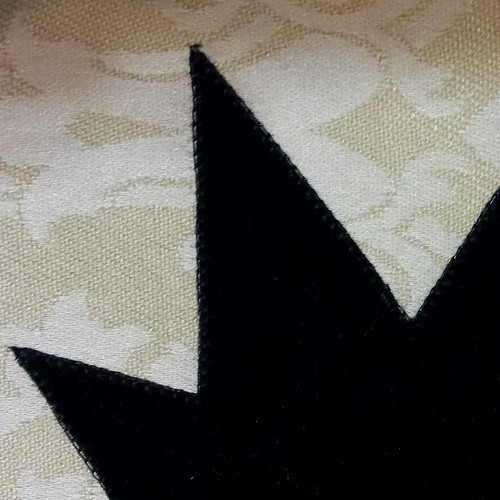
Any banner that is going to sit next to Giant Sparkly Banner is going to need a little pizazz, so I dug out my left over gold twist. I couched the gold twist around all of the edges by hand, on top of the blanket stitch. The result is nice. The gold twist makes a nice contrast border for the velvet and adds some sparkle, while also covering up any stray machine stitching that wasn't exactly flush with the edge of the charges.
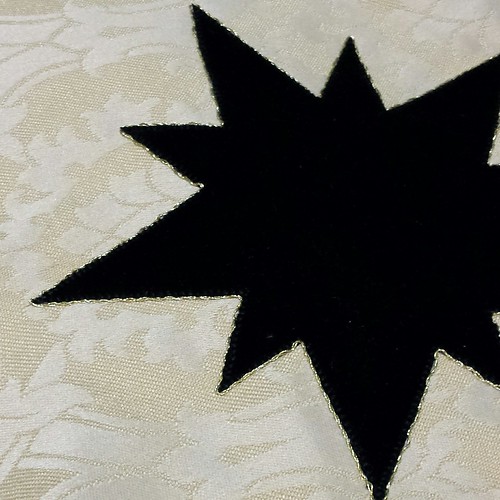
I left the fused stabilizer on the back, which made the stitching for the couching quick work. I didn't need a hoop or frame, since my tension was perfect. The lightweight tear-away stabilizer didn't hamper my the needle work at all. Below you can see the back of the pieces with visible machine work in black and hand work in gold.
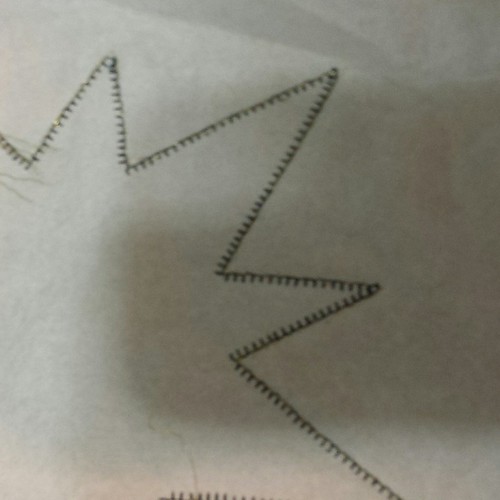
Overall, this was a great approach to get maximum bang for my time. I started to feel like the project was dragging, but then realized that there were six of these things! After the embroidery was all finished, I ironed out the pieces, squared them off, and cut the canvas backing. This part was all classic quilter's skills, except I had a stack of brocade, which is less cooperative than quilter's cottons. Again, I found that you can never have too many binder clips and there is always a use for more. After taming the wild brocade and squaring things off I managed to actually hit my target of a width of 12 inches for the banners (although some of my hems will be very small). In another stunning development, when I finally hung them up, the charges are all lined up correctly. I kind of held my breath on that one, because no matter how much you plan and check and re-check you always fear that something weird would happen. Will one be out of vertical alignement? horizontal alignment? upside down? I kind of just stood there and stared for a bit when they turned out just fine. Hooray!

Monday, July 28, 2014
Actual rivets

The sequence is from right to left for no reason other than that is the angle that I took the picture.
- First make a hole an pop the nail through.
- Slide the washer over the nail. The tighter the fit on the washer, the less rattling around and jumping you get. This washer is probably too loose, but it's what I had on hand.
- Clip the nail fairly close to the washer. You don't want it flush, since you need some metal to spread out for the rivet. I've got some handy metal shears for this that work well and help you develop your forearm strength.
- Hammer down the nail into a nice rivet. You can use the flat part of the hammer to spread the metal and the rounded part to shape it into a nice even dome.
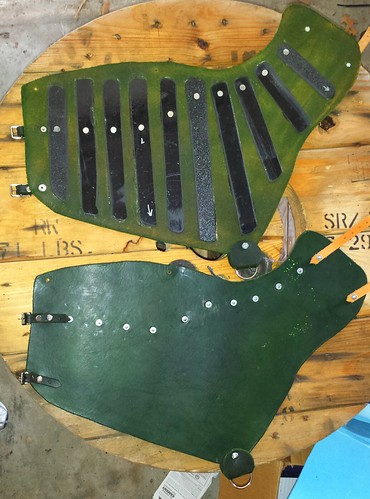
Wednesday, June 4, 2014
Riveting news!
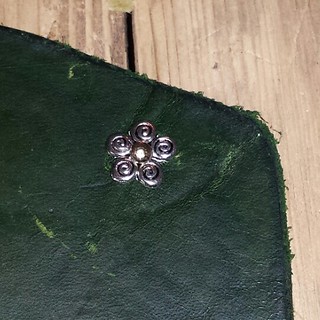
I've been looking for some pretty rivets since the planning stages of my armor upgrades. I want something pretty, but don't have the budget for the super nice historical replicas. These are my favorite thus far. They are cheap and if you squint really hard, they look kind of rose or flower-ish. The metal is a decent thickness, so they should hold up ok. I think that they will look fairly nice. I am almost at the riveting, so unless I find a better option before I finish drilling holes, these are it!
Thursday, May 29, 2014
Pouncing Armor!
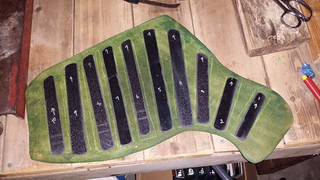
When we last left my leg armor, I was getting the splints together. After cutting them out on the Beverly shears, I handed them off to Master Jovian. He was kind enough to grind the edges smooth for me. Above you can see the now not-jagged splints ready to go.

I hate getting rivet holes to line up and dealing with plastic and leather shifting about, so I have decided to eliminate the problem with copius amounts of contact cement. The contact cement probably wouldn't survive fighter practice, but it will hold things together long enough for me to drill and rivet with minimal fuss. Here is my sticky, gooey progress.
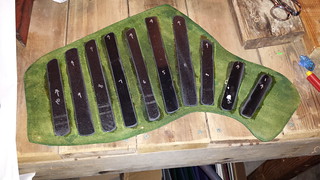
Once the contact cement cured, I placed all the splints in their proper position. This felt a bit like a surgical procedure, since one false move and the plate is stuck forever. Well, probably not forever, but there is no wiggle room with dropping the plates. Contact cement does it's job well and the one splint that I tried to re-position would not budge even the slightest.
Some of my projects have extensive plans that go into great details. Many have "the magic happens here" steps that lead to creativity, innovation, and occasionally weeping. For some reason, my magic step here was "do the other leg". Since I had done all the plate positioning directly on the first leg I didn't really have a pattern to work with. What to do? The answer was prick and pounce - armor style!
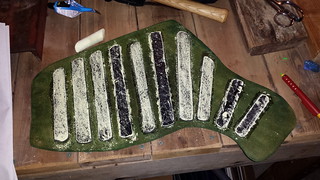
I borrowed my son's sidewalk chalk and used it to make maximum mess on the splint plates. The plates with the texture side up did a much better job of being chalky, but the smooth plates did adequate. When all the splints were thoroughly dusted, I carefully lined up the two pieces, flipped them over, pressed down carefully (no shifting!), and then removed the chalked piece.
Thursday, May 22, 2014
Acts of random dye-ness

I was making myself a nice cabbage dish the other day and couldn't bring myself to throw out the pot of bright purple water. So, instead I added some thread. Perfectly logical. Anyway, here's the results of the test run. Above is are the three samples {wool, nice spun silk, cheap silk} dyed with purple cabbage using a cream of tartar mordant and a bit of vinegar on the rinse. I like that all three of the pinks come from the same batch. The cheap silk made the brightest pink. Also, since purple cabbage makes a nice litmus test (literally) you can see the clothespins with their nice basic wood (pink) and apparently something acidic going on with the metal (green). You can use your excess cabbage to make litmus strips and test all the things for fun! Science! Yay!
I liked the result and then got to thinging "Now what am I going to do with this?" Obviously I needed another color, so I found another skein of the cheap silk and let it stew in the left-over coffee from yesterday. After drying I got a really nice yellow out of it. So there you have it - random project complete. I'm really not sure what I'm going to do with it yet. The colors on these threads will be more delicate, so I won't make anything that must be washed frequently or with gusto.
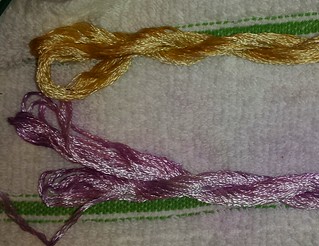
Tuesday, April 8, 2014
Leg armor progress

I've resumed work on upgrading my armor, starting with the legs that I was working on. The pieces had been previously cut and dyed, and then laid on a shelf where they weren't doing much of anything. So, this weekend I decided to make some progress. I punched rivet holes and gave them a nice coat of neatsfoot oil. The oil darkened the green dye a bit, but greatly improved the handling and feel of the leather. In the picture above you can see the legs partially assembled with the knee cops.
I borrowed some beverly shears from a friend of mine and got to work cutting out plates for splinting the thighs. I've mounted the shears using some C-clamps onto a wooden spool that I picked up for $5 from the electric company. The spool is heavy enough to be sturdy, small enough to fit in the back of my micro van, and the round shape makes it relatively easy to move around. This setup worked really well and I got all the plates for the thighs cut out.
And here is what two sets of thigh splints look like after they are pattern drafted, cut, and laid out. I still need to grind the edges, since they are a bit rough in places.
What armor kit would be complete with out some fashionable bling? Ok, it's 14th century fashion, but still - fashionable. I pulled out some thinner black leather and cut dagging strips for my knee cops. The black helped contrast against the green, making it appear less dark. I decided that the contrast needed a bit more zing, so I painted a white border around the edges of the dagging. It looks even nicer than I imagined! As an added benefit the paint sealed the leather on the edges and made the dagging cuts look more tidy.
Sunday, March 23, 2014
Giant Sparkly Banner on Tour

Giant Sparkly Banner made a trip to Kingdom A&S and to Bryn Gwlad A&S competitions. Above are pictures of it in action. Below is a picture of the banner completed getting ready to go traveling.
My display used two trays: one for materials and one for technique. The materials tray contained my tools including scissors, needles (in the needlebook), and a laying tool. I made skeins with the threads I used in the green, the passing gold, and the gold twist. Finally, I included a sample of the gold twist lucet cord, which I stored on a thread winder.
The second tray displayed the various steps for the embroidery. The two fill patters were embroidered in a series of steps
- Foundation: The foundation layer is the white interface foundation which was cut to design and ironed on the brocade. In the sample the white layer is shown at either end of the swatch.
- Laid green stitching: The green threads were laid down for full coverage of the foundation. The stitch length for the green thread is much longer than most embroidery stitches because it will be couched down later. You can see in the picture that the green thread drifts and wiggles where there are no layers above it.
- Laid gold stitching: The next layer was gold passing thread embroidered in laid work pattern, which was on top of the green embroidery. The letters were embroidered in open laid work using a grid pattern. The leaves of the wreath was patterned after Gabriel's wings from an alter frontal so the only laid work was the single gold twist thread along the center. The top half of the sample shows the laid gold threads before they are couched. There is still some shifting of the gold and green threads and the sheen is at a uniform angle.
- Couching:After the laid work is finished, the gold pattern (grid or wing/leaf) was couched down. For the grid pattern on the letters, each intersection is couched with a single stitch of gold passing thread. For the wing pattern on the leaves of the wreath, the center gold twist is couched with a longer stitch at an acute angle. The leaves have fewer couching stitches, but the stitches are longer and cover more of the green thread. The bottom half of the stitching in the sample shows the grid with the intersection couched down. The couched intersection gives the work a more dimensional look which adds more sparkle. On the far right end of the swatch you can see the grid couched down without the green layer, to show the couching stitches more clearly.
- Outline: The final step for each embroidered motif was to add an outline of couched gold twist. The sample shows the gold twist couched on the bottom of the foundation layer. On the right side of the swatch,
the end of the twist has been plunged (pulled through the
brocade) as is normally done on finished embroidery. This is
a good example of why the foundation and brocade
combination work so well. The foundation provides stability
for the couching stitches, which the looser weave of the
brocade allows the much thicker gold twist to be pulled
through to the back without creating tears or runs in the
weave. The left side of the swatch shows the gold twist left
loose on the top, which is what it looks like while it is being
couched. You can immediately see that the biggest challenge
here is holding the thread in place for stitching, while trying to
keep the twist and prevent fraying of the top threads.
